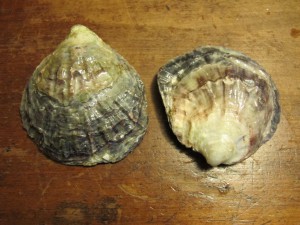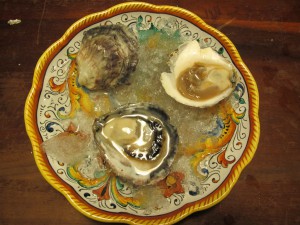Belons from Maine
Oct 21, 2011
Belons are the rarest oysters in North America. More rightfully known as European Flats (Belon refers to a river in France that grows the finest), or Ostrea edulis, Belons are the native oyster of Europe and the big cousins of the Pacific Northwest’s Olympia, but they are an entirely different genus from the rest of our oysters. They act different, and they taste different. Way different. We’ll get there in a moment.
First, take a look. Belons resemble the love child of a scallop and an oyster. They are always roundish and relatively shallow-cupped (hence their nickname, “flats”).

Nonesuch Belons
Inside, they tend to have a rust-colored mantle. (I flipped the one on the bottom, which was an irregular looking oyster anyway; the one on the right is typical.)

But forget the looks. What sets Belons far, far from the madding crowd is taste. They are, quite simply, the most intense, overwhelming, unforgettable food you are likely to eat anytime soon. They are the Sean Penn of oysters–scary, but you feel compelled to keep paying attention. The French say that they have a noisette (hazelnut) finish. I don’t know what kind of Chernobyl-irradiated noisettes the French are eating, but I never thought of hazelnut with a Belon. Chugging iodine, maybe.
But that, of course, is if you eat them unadorned. Don’t. They were made for lemon–and they make me break my rule of never putting anything on great oysters. Belons scream for a little lemon, which, magically, makes all the iodine disappear, leaving something beautiful and, frankly, indescribable in its place. If the Japanese nature god of lemons visited an onsen (bath house) and, after he’d departed, you slurped a little of his water, it might taste like this. Uplifting, aromatic, and strange. You’ll have to try it for yourself.
And try it you can! I’m pleased to say that, after a stretch when it looked like this oyster might go extinct (99% of the French industry uses the same Pacific oyster now used on the West Coast), we have a farmer in Maine who is successfully growing them, thanks, in part, to a grant from the Down East Institute. Abigail Carroll, of Nonesuch Oysters, is now the main supplier of Belons to Grand Central Oyster Bar. Kudos to Abigail for taking on the daunting task of keeping the finicky, die-if-you-look-at-them-sideways Belons alive all the way to harvest size (and on to market; Belons have weak adductor muscles and have trouble keeping their shells closed, so they need to be banded with rubber bands until shucking time). If you see her Belons anywhere, try them. It will be an experience. And experience is always good–right?
- Naked Belons
« PREVIOUS: ICOB–A New Standard in Oyster Bars
» NEXT: The Aw Shucks Oyster Opener
 Recent Posts
Recent Posts
